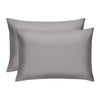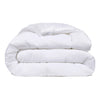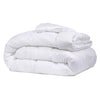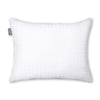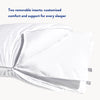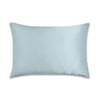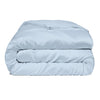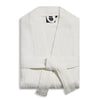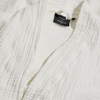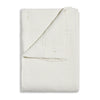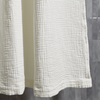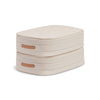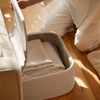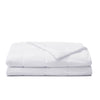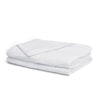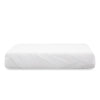The Daily Miracle
How To Wash Pillows: The Best Way
Published
October 30, 2022
Author
Bridget Reed

When it comes to keeping your bedding clean, some things are easy. Washing bed sheets, blankets, and duvet covers are pretty intuitive and, depending on the materials, often not much different from washing your clothing. But there are some less-obvious aspects of your bedding that you may not know how to handle.
So let’s talk about pillows:
Like the rest of your bedding, keeping your pillows clean is vital for many reasons. Let’s discuss some of these reasons. Then, we’ll break down the best way to wash pillows to ensure they stay clean and fresh.
Why Is It Important To Clean Your Bedding Regularly?
The main reason you want to clean your bedding regularly is the same reason you wash anything else you own. You don’t want it accumulating dust, dirt, dead skin cells, germs, bacteria, fungus, or any other impurities. Some of these can negatively impact your health and comfort… or even just cause unpleasant smells.
Unfortunately, even if you use a pillowcase, your pillow is likely to absorb things over time. In fact, some studies have shown that pillows can be a significant source of fungi in your bedding. While thick, cushy pillows are great for many reasons, their ability to collect dirt and impurities isn’t one of them.
Dirty bedding, especially pillows which come into contact with the bare skin of your face nightly, can lead to breakouts and other skin conditions. It can also exacerbate allergies if you’re sensitive to dust mites.
And just in general, once you know all the things that can go wrong with dirty bedding, it can be hard to get a good night’s sleep when you’re worrying about what’s going on inside your pillow.
So let’s talk about some tips for washing your pillows.
Start by Checking the Care Label
Your first step should always be to check the care instructions on your pillows. Some types of pillows, like memory foam pillows, for instance, may require dry cleaning or hand washing so as to avoid clumping and other negative effects. Any special instructions shown on the care label should be followed to the letter for optimal results.
But other than that…
Spot Treat Stains
This is important because it can prevent stains from setting in and make them easier to remove once your pillow gets into the washing machine. You should spot clean first because the longer you wait, the more likely that stain is to stick around and get in the way of your dreams of clean pillows.
Just apply a mild detergent or stain-specific cleaner to the soiled areas before moving on to the next steps.
Two’s Company
Ideally, you’ll want to wash your pillows in a washing machine that doesn’t have an agitator — that spindle in the middle that swishes all of your items around during the wash. Whether it’s front-loading or top-loading, this type of washer may damage your pillows. However, the bigger concern is your pillow getting stuck during the wash cycle and preventing the suds from getting where they need to go.
But if you are using a washing machine with an agitator, you’ll want to wash two pillows at a time on a gentle cycle. This will help keep things balanced, enabling hot water and soap to work their magic on your pillows more evenly.
Cool or Warm Water
Unless your care instructions say otherwise, you’ll want to wash your pillows with cool or, at most, warm water. While it may be tempting to go hot to really break down any build-up on your pillows or use cold water to be extra conscientious, somewhere in the middle is probably best.
Gentle Detergent
The other big question regarding a machine wash is the laundry detergent you use. This isn’t the time for harsh chemicals or bleach — you’ll want to keep things gentle to preserve everything you love about your pillow. You’ll also want to be sure your soap solution is substantial enough to get rid of any allergens, mildew, or body oils that may have built up on your pillow.
Zero-waste laundry sheets are a great option for keeping your bedding clean without harming the environment. Our Laundry Detergent Sheets use the magic of anti-microbial silver to help prevent bacterial growth, even after you wash.
This is ideal for items like pillows, which you should be washing every six months on average. If you want to use a fabric softener as well, check the materials used in your pillow first.
Dry Thoroughly but Gently
When it comes to drying your favorite down or feather pillows, your first priority should be drying them completely. If you half-dry your pillow and then return it to its pillowcase and pillow cover, you’re just tempting fate when it comes to mold, mildew, and other unpleasant things.
Plus, while your pillow may feel dry to the touch, if it’s not completely dry, you’re probably going to be able to feel that residual dampness when you rest your head on your bed pillows.
If your pillow is machine washable, it’s probably dryer safe too. Still, stick to moderate or low heat, depending on your pillow type.
To speed up the process, you can add a couple of dry towels to your dryer with the pillows, which will absorb excess liquid. Tennis balls (or dryer balls) can also keep your pillow’s fluff in pristine condition while they dry.
If you’d rather not put your pillows in the dryer, you can air-dry them, do it somewhere with adequate air circulation and be patient.
Keep Your Pillows Clean Between Washes
This is the number one thing you can do to improve the cleanliness of your pillows.
While washing tips are vital, and washing your pillows regularly is crucial, taking some additional steps to keep your pillows in good knick between washes can make the whole process a lot easier.
Always use pillow protectors and pillowcases, for one! These things help to protect the pillow within and are much easier to wash on a regular basis. This can increase the time between much-needed but time-consuming whole pillow washes.
Our Extra Luxe Pillow Cases are made with natural silver, which has antibacterial properties so that you can say goodbye to odors and bacteria growth. This means that you have to wash your pillows themselves less frequently, and your pillowcases will feel fresher and longer, too!
Our Miracle Made Pillowcases are super soft because they’re made from USA-grown Supima cotton, so you can drift off knowing your bedding is clean and comfy to boot.
Pillows Aren’t Meant To Last Forever
Lastly, it’s important to note that your pillows are usually not intended to last forever. While care and hygiene can extend their lifespan, you should really be swapping old pillows for new pillows every one to two years at most.
In Conclusion
Keeping your bedding clean is exactly nobody’s favorite chore. But knowing how to clean everything on your bed is essential for restful sleep and your overall wellness — not to mention your peace of mind! With these tips, we’re sure you’ll master how to wash pillows (the best way) in no time.
Sources:
Fungal Contamination of Bedding | Wiley Online Library
How Often Should an Acne-Prone Person Change His/Her Pillowcase? | Acne.org


